- Product Name: Fire-i
- Company: Unibrain
- URL: http://www.unibrain.com/home/
- Category: Webcam
- Price: $99
- Requirements: OS X or OS 9 Mac with FireWire
- Rating: 3 bounces – Lustworthy
Webcams are among my favourite computer accessories because they are inexpensive and versatile. They can be used to take stills of adequate quality for webpages and the like, and as movie cameras they are great for recording family events for burning to CD and sharing with others. I’ve used webcams to film kittens for a cat breeder, to produce movies for kids to share with their parents, and to photograph astronomical equipment for my web site. But my favourite use of webcams is for simple astrophotography. Although inferior to cooled, long-exposure CCD cameras, webcams do have the benefit of costing far less and being simple enough to get good results with almost at once.
Until recently, the majority of Mac-compatible webcams have been USB devices. The main reason for this has been the widespread use of the Universal Serial Bus (or USB) version 1.1 interface by both Apple and the various PC manufacturers for their computers, making it cost-effective for webcams that support both operating systems to be produced and distributed. The USB interface is convenient and reliable, but it is relatively slow, with a maximum data transfer rate of about 1 MB per second. This creates a bottleneck between the image data the webcam is collecting at one end and the computer receiving the data at the other. What USB webcams do is to compress the data before sending it down the USB cable; that way they keep the actual amount of data being sent manageable while trying to keep the image quality reasonably high. Up to a point, this works, but if you try to record high resolution movies (say, 640 by 480 pixels) in full colour and with a decent frame rate (around 30 frames per second), the compromises the camera has to make become very evident. What normally happens is the frame rate drops to keep the image quality of each frame within the parameters desired, so instead of a flowing, real-time movie you only get more of a slide show effect, with only five or ten frames per second. Aggravating the problem is the compression, which is lossy, so that while each frame appears reasonably detailed, small features can become blurry. This is especially obvious if you are using the webcam on a microscope or telescope where the target object covers only a small part of the CCD, and you want every scrap of image fidelity you can get. Basically, with USB you can either have high resolution or a fast frame rate, you can’t have both. The solution is to avoid the USB bottleneck by using FireWire, a much faster interface (400 MB per second) that allows both high resolution and rapid frame rates.
In this Corner… the iBot Pro from Orange Micro
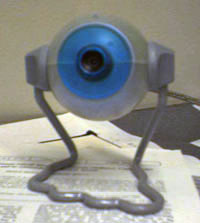 |
| The iBot, imaged using the Fire-i |
The design of the iBot is conventional in many regards, a spherical camera on a mount, though with a FireWire cable hanging from the back instead of a USB one. Focusing is accomplished by turning a blue ring around the lens, but unlike many such focusers (including that on the Fire-i camera), this ring is comfortably stiff and textured, so that the action of turning the focuser is positive and accurate. The iBot feels very solid, in part because of the sturdy FireWire cable it comes with, but also because of the heavy metal foot-shaped stand it comes with. This foot is certainly whimsical, and combined with the cheerful eye-like design of the camera body, makes the iBot one of the most friendly-looking bits of Mac equipment around. The stand works well, and keeps the camera pointing where you want it stably and reliably even on a polished desk, through sheer weight alone more than anything else. The “arms†of the foot that hold the camera body squeeze inwards slightly, holding the angle of the camera very tightly, so even if you focus the camera it won’t slip down from wherever it was pointing before. What the stand doesn’t accomplish is allow the user to clip the camera onto a monitor or laptop screen as is the case with the Fire-i camera or for that matter many of the USB webcams such as the Philips ToUCam. On the other hand, the extra weight it gives the camera and stiffness of the camera within the mounting makes the camera very nice to use placed on a desk, and combined with the included headset and the nicely designed focuser, this is easily one of the nicest webcams around for videoconferencing.
The iBot Pro package is remarkably good value given what’s included. It includes the iBot camera, which can be bought separately for $99, OS X and OS 9 drivers from IOXperts ($20), and a headphone-microphone headset for video-conferencing. Okay the latter is pretty cheap and cheerful (about on par with the headphones you get given on airliners) but it’s usable. Utility software includes the BTV Pro ($40) movie and frame capturing application, two applications from ArcSoft for image and movie editing, Video Impression and Photo Impression ($50 a piece), iSpQ’s VideoChat ($40) video instant messaging software and finally iVisit’s Video Conferencing Software (free download). All told, that’s a lot of decent software for a measly thirty buck surcharge over the regular version of the iBot.
And in the Other Corner… the Fire-i from Unibrain
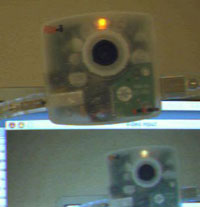 |
| The Fire-i, imaged using the iBot |
The Fire-i camera is much smaller than the iBot and lacks a microphone. It also eschews a conventional stand in favour of a very robust clip at the back with which the user can attach it to an LCD screen or laptop monitor. The clip is cushioned on the inside so shouldn’t damage anything it bites onto. It’s less obvious to me how the thing could be fixed to a traditional CRT computer screen or an older iMac, though. Another problem is that connection between the clip and the back of the camera rotates, and with the weight of the FireWire cable pulling on one side of the camera, the webcam did tend to slant over to one side, which could be annoying when videoconferencing. A more obviously useful and innovative aspect of the Fire-I design is that it has two FireWire ports, one of which is used to plug the (supplied) FireWire cable from the computer into, but this still leaves the other one free. This is great, because it means you can daisy chain FireWire devices if you have a Mac with only a single FireWire port (as is the case with the iBooks and many of the PowerBooks as well as older PowerMacs and iMacs). You can even plug in another FireWire webcam, as I did, and record the same thing from different angles. The fact the FireWire cable that comes with this camera is detachable is nice, because it can always be pressed into service with other devices. As every experienced computer user will tell you, you can never have too many spare cables! Another interesting design feature is the existence of a DC power input. The power supply for this isn’t included with the camera, but details of what’s needed are on the FAQ at Unibrain’s website or it can be bought from their online store for $13. For most users however the FireWire cable will provide all the power that’s needed.
The Fire-i webcam comes with just two applications, and these are trial versions at that; for full functionality the user will need to pay the extra $20 to register the bundled copies of BTV (the basic version, not BTV Pro) and $40 for the iSpQ VideoChat videoconferencing software. Both applications come as OS 9 and OS X compatible versions. Admittedly, the Fire-i is thirty dollars cheaper than the iBot Pro, and the $99 basic iBot also comes with just the trial version of BTV Pro rather than the full application. But on paper at least, if you don’t have any of these applications, and think you’re going to need them, the iBot Pro bundle is much more attractive.
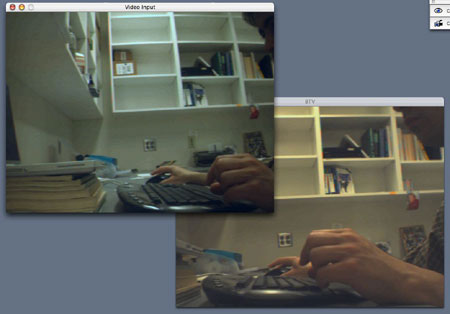
Round 1: Field of View and False Colour
When the cameras are sitting side by side and focused on the same target, an immediate difference in the width of field taken in by each camera can be seen, presumably due to differences in the lenses used. The iBot records a wider field but with much more obvious curvature because of its substantially wider field of view (look at the shelving in the background), whereas the Fire-i takes in a narrower field with no obvious curvature at all.
One flaw common to both cameras was false colour, though this was most noticeable using the Fire-i camera’s default settings. This false colour is a result of the compression mode used by the
camera and can to some extent be reduced by switching compression modes. Varying the video preferences also helps whatever the mode, for example false colour becomes less apparent when the gain is turned down, and isn’t really detectable in frames smaller than 640 by 480 pixels. Even at its worst, false colour is a feature of sharp, bright edges against darker backgrounds, rather than softer, more uniformly illuminated objects like faces or people.
 |
| The iBot (left) takes in a wider field of view, but at the cost of curvature, but false colour is obvious on bright objects with the Fire-i (right). |
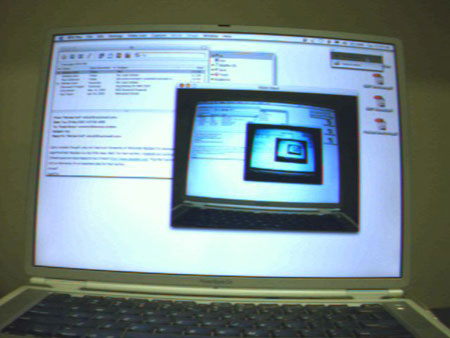 |
| This shot of my PowerBook taken by the iBot really shows off the curvature in its field of view. |
The wider field of view of the iBot could make it a bit more attractive for situations where the camera is being used as a simple camcorder type of device, for example for recording groups of people. But if you’re looking for a webcam to be used as much as a cheap digital camera for taking still images of things to put on a webpage or into a catalogue, the curvature in the field of view could be problematic.
Round 2: Image Quality and Frame Rates
Image quality of both cameras was good, though not camcorder quality by any means. I didn’t feel the images were any brighter or clearer than those from a decent USB 1.1 camera. To be honest, I feel the advertising on the iBot that highlights the fact these webcams use the same FireWire technology as digital camcorders was a bit misleading since they don’t offer anything like camcorder image quality. What FireWire does allow are faster frame rates than is possible with USB 1.1. Image quality is instead a function of the design of the webcam, in particular the CCD and the lens. Of the two, the Fire-i struck me as being the better imaged; in particular was remarkably good was as a short focus ‘macro’ camera, as shown in the close-up of my keyboard below.
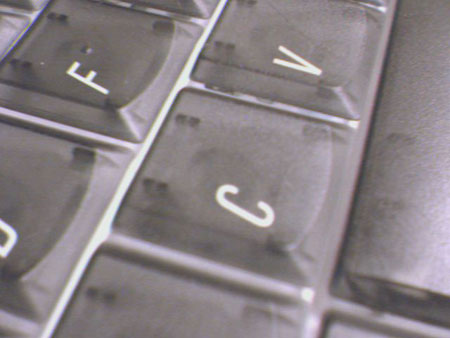 |
| A close-up view of the keyboard of my Ti Book. |
Round 3: Bundled Software
Both cameras come with a version of BTV, a time-limited trial version with the Fire-i and a registered copy of BTV Pro with the iBot, though it is limited to use with the iBot camera only. BTV is a fine application, very easy to use, though endlessly configurable giving the user lots of potential for experimenting with things like colour balance, gain and frame rates. The Pro version adds some extras like the ability to stack frames on the fly for noise reduction, AppleScript support, motion detection and more.
The two processing applications, Photo Impression and Video Impression, that come with the iBot are impressive. While they won’t replace Adobe Photoshop or iMovie, they are very fair substitutes for lightweight work. Photo Impression has a slightly annoying interface eschewing the Aqua interface for its own full-screen interface. But it works, and the feature set is surprisingly good, covering all the basic retouching and editing tools. Video Impression has a similar sort of interface but not full screen, and allows the user to slot transitions in between successive movies, text captions, and soundtracks.
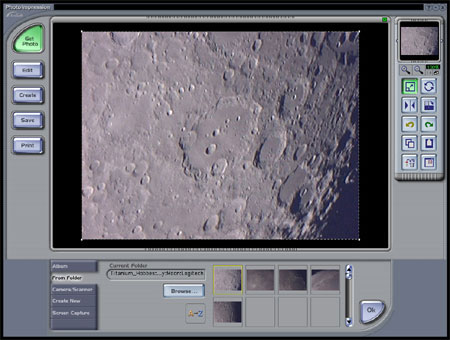 |
| Photo Impression is a nice image editing package a big step above AppleWorks and a useful OS X application for lightweight graphics work. |
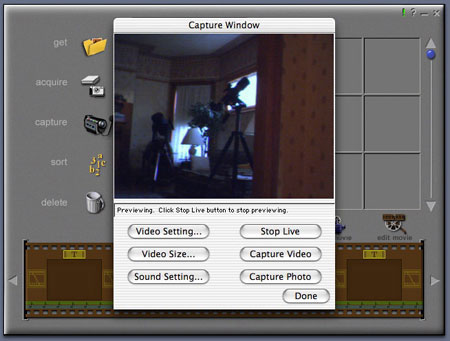 |
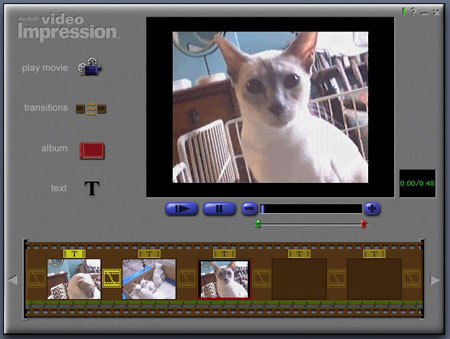 |
| Video Impression includes movie grabbing tools (top) and a variety of tools for adding transitions, captions, and so on to make longer movies by sticking together shorter ones (bottom). |
Round 4: Low Light Conditions
I tested both of the cameras in low light conditions, by which I mean a desk in a room at night with just a table lamp for illumination. Surprisingly, performance wasn’t at all similar here, the Fire-i camera being well ahead of the iBot. Both cameras did suffer from a strange defect in the images they recorded, the left hand third of the frame being darker than the rest of the frame. This was inexplicable to me. Whatever its cause, the Fire-i suffered much less, and with some tweaking of the video settings (particularly the gain, exposure and shutter speed) remarkably good performance in low light conditions could be obtained. In comparison iBot images remained rather washed out and grainy.
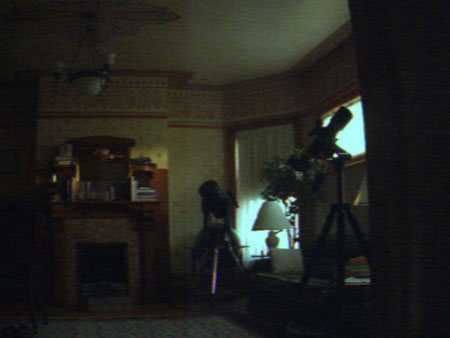 |
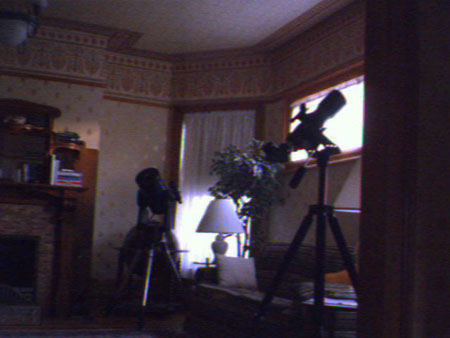 |
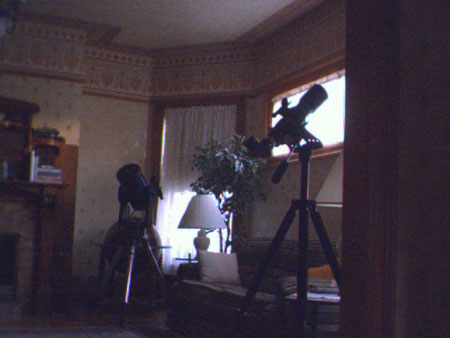 |
| Under low light conditions, the iBot delivered relatively grainy images (top) compared to the Fire-i camera which seemed to work acceptably well with the default settings (middle) and even better with a bit of tweaking to the video settings (bottom). |
Round 5: Astrophotography
Because the Fire-i was on loan, I couldn’t take it apart and remove the lens, but the iBot was used for some astrophotography, and the results were satisfying. It should be mentioned that the focusing ring on the iBot can be wound out completely (with a bit of force towards the end) and with it comes the lens. One of Steven Mogg’s webcam adapters can be screwed in; he produces ones especially for the iBot but I happened to have a Philips ToUCam adapter that worked perfectly. Performance seemed well above that of the ToUCam and about as good as the Logitech 3000 camera. The colour and contrast of the shots I took of Jupiter were perhaps a shade inferior to those I’d taken with the Logitech, though it was difficult to be absolutely sure about this because Jupiter was lower in the sky than would be ideal at the time I was writing this review. Performance on the Moon and stars was impressive though, with decent resolution of tight doubles like Epsilon Bootis. All in all, a camera well worth considering for astrophotography. As for the Fire-i, given its better performance in low light conditions, it should be even better, but without being able to take it apart and test it, I can’t say for sure.
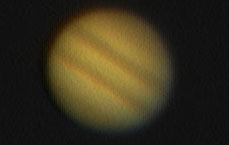 |
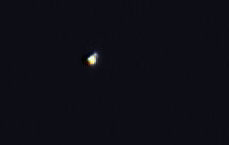 |
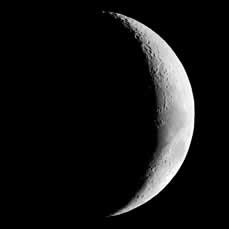 |
| The iBot delivered useful movies of astronomical objects, such as these of Jupiter, the tight double Epsilon Bootis, and the Moon. Processed with Keith’s Image Stacker and Adobe Photoshop. |
And the Winner is…
If you were looking for a basic webcam with decent performance that came with all the accessories and software you’re likely to need, then I would have to recommend the iBot Pro simply because of the uncommonly strong bundle of software that it comes with. I’m just not a fan of hardware manufacturers including demo or trial versions of shareware applications with their products. I much prefer the approach taken by Orange Micro where a modest increase in price is used to cover the cost of a useful suite of software. For the user looking for a complete imaging and editing package, the extra thirty dollars for the iBot Pro is money well spent. The design of the iBot is nice and well suited to videoconferencing.
However, the iBot taken as a webcam alone doesn’t perform as well as the Fire-i as an all-round imager. The Fire-i works well in low-light conditions and in close-up, and the images are flatter and more contrasty. The design is clever, with the extra Fire-Wire port and removable cable, and though I wonder about the lack of a proper stand and a microphone, on my laptop the clip works reasonably well. I don’t like the focuser on the Fire-i as much as the one on the iBot though, it’s just a bit too loose to feel positive. Of the two cameras then, the iBot Pro package is certainly the more compelling, but the Fire-i camera must get the nod as the better performer.

Leave a Reply
You must be logged in to post a comment.